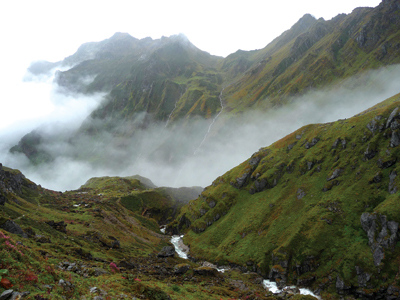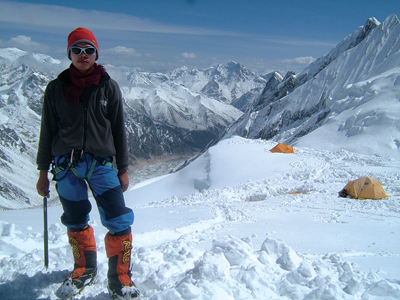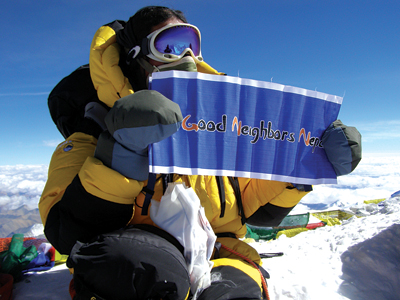For my part, I travel not to go anywhere, but to go. I travel for travel’s sake. The great affair is to move. - Robert Louis Stevenson (Travels With A Donkey, 1879)
What makes an adventurer?
It is an age old question, asked down through now long-forgotten ages. Is it muscles and pomp, or a recklessness with ones own life or with that of others?
I often wondered about these things as I grew up, reading books like Swiss Family Robinson, Robinson Cruscoe and the adventures of little Huckelberry Finn. Until recently I can honestly say that I knew no better, within my child’s mind, I would craft strong macho Indiana Jones-esque characters, resplendant with leather whip and widebrimmed hat. But, then I met Antonio, and well, this man I can say, is indeed an explorer, deserving of the title, and yet he carries no whip that I can see, and that only made me more curious.
I sit with Juan Antonia Sanchez, a lean, olive-skinned man, dark haired and clean shaved, we share coffee on a veranda over looking a chaotic Kathmandu street, cars and rickshaws battle for inches, and I can see this is not Antonio’s natural environment. He’s busy these day, like most of his days. He is between meetings as we talk, working on getting grants and teams organized for the next big exploration trip into the Himalayas. “Every journey I do has to be about exploration”, he tells me, as a glint appears in his eyes. He hasn’t been in Nepal that long, a year and a half and his company Enlightenment Treks and Expeditions, isn’t that old, but he has not been wasting any time. Already he is starting to leave his print on these mountains.
 Knocking titles off pedestals
Knocking titles off pedestals
The next mission is taking him and the team back up to Rasuwa District, above Gosaikunda Lake; it seems they recently sniffed out a new “highest lake” of Nepal. He is beyond excited, and is off soon, with the team, to take the offical altitude readings, to confirm if it is really true. If so, it will mean that good old Tilicho Lake, sitting at 4,949m., will soon be pushed off its pedestal —literally. The answer will be with us shortly, once the weather is that little bit better for the task.
But Antonio is not stopping there, to rest on his laurels, he’s already in talks with National Geographic, for an exploration grant, as well as joining the team, when they go to research and explore the areas of far-flung, far-western Nepal. They will travel on foot beyond the Annapurnas and Dhaulagiri 6(Putha Hiunchuli), beyond Jumla all the way to Humla, and Saipal, an area that claimed lives on the last exploration team that went that was, in the 1990’s. It is a part of the country that is hugely unknown, even to its inhabitants. It is a part of our world that is still raw, wild and even uncharted, steeped in deep mystery and wonder—both natural and divine. There will be no shortage of great stories for NatGeo to show us here, as well as those in the outside world.
The Himalayas have long been frought with dangers, it is the way of such mountains, they are not considered record setters for nothing. Every year sees tragedy on those high slopes, whether it is with novice trekkers, or experienced climbers, both local and foreign. Danger is hard to predict, theres are too many factors to consider such as High Altitude Sickness, avalanches, rock slides and even just poor luck, such as slipping at the wrong moment. Then what happens in the event of injury? Helicopters are possible, but only to certain elevations. In the end, it is still always going to be a challenge between man and the mountains.
 The hungry bunch
The hungry bunch
Antonio has been building a strong team of Nepali climbers, who are both aware of the dangers and equally hungry, to explore the unknown parts of their country. They are people who are well tuned-in, to the dangers of Nepali mountain exploration.
The team includes noteworthy climbers, like Chotemba Sherpa of Makalu, who since the age of 15, has worked his way up from being a porter, using deep determination and passion. He has been part of both Nepali Himalayan and French Alpine expeditions for a long time. To date he has notched 14 Himalayan peaks to his belt. Another esteemed climber is Usha Bista, a lady above the rest, in the country, literally, and probably has more experience of Himalayan dangers than most of her male couterparts. Three years before, she lost her thumb on the Hillary Step, while ascending Mount Everest; it was her first attempt. It had to be cut off due to frostbite, after she was left behind by her colleagues, as they continued on up to the top of the world. Thankfully a kind Canadian woman came along and helped her, slowly, back down. Since then she has been climbing peaks with gusto and determination, and not just here, but some of the worlds biggest peaks in Australia and Russia. On top of that she went back and scaled Mt. Everest and any fears she may have had.
As for the man at the wheel, he has his own long-line of credentials, well built since he left his home in Seville, in sunny Spain, many years ago. Antonio arrived to Nepal after seven years of cutting out new tracks, through South American rainforests, mostly in Columbia and Panama. Also, he has spent much time climbing and exploring around California’s Sierra Nevada mountains. Then for fun he added healthy amounts of adrenaline packed motocross (driving special motorbikes over rough terrain), and bucket loads of mountain biking to his repertoire.
The team seems strong, definetly so as a group of individuals, they are thankfully aware of what lies ahead. Often we tend to forget how truly dangerous it can be up there, especially when what we see of the place are picturesque images of magical places. We rarely tend to think of the underlying currents of danger that exists when one truly ‘goes off the beaten track’. There will be no aid posts or doctors to help in the event of mishap, they will be for the most part, on their own, with their own skills to depend on. Every single item of equipment and food has to be carried, and luxuries like hot washes and full meals will become a distant memory. But that is the life of explorers, it wasn’t much better for Dr. Livingston when he disappeared into the dark heart of Africa centuries ago, looking for the source of the River Nile. Exploration will still always be exploration, even in this, the 21st Century.
Ironically the team plans that once the far-western exploration project ends, they will raft down the mighty Karnali River, which runs not far from Jumla, all the way to Bardia on the Indian border. A wild glint appears as he says it, perhaps he can already feel the adrenalin rush of riding such a colossal amount of water. Why not? Better than walking back down, and it is always good to have a change in the mode that ones travels. It will be a hell of a way to wrap up the mission, and welcome respite on the legs, which I am sure will be well worn out by then.
 No rest from one’s passion
No rest from one’s passion
When Antonio is not roaming the mountains, he keeps himself away in Pharping, a few kilometers outside of Kathmandu city, tucked in next to the mountains of the valley. Even there he has not been resting on any laurels, and has discovered a new hot-spring, known only to a few locals and unheard of within the valley. Antonio smiles as he tells how the locals go to boil their eggs in the water; it is that hot. When not busy with his passion for exploration, he keeps himself busy studying Buddhism with the numerous lamas, in the monasteries now dotted around the area. And, he is about to start a new kind of trekking route from there, something else that is new in Nepal, moving away again from the conventional style.
Now, they have created a trekking package for people eager to learn. The idea is simple, even possibly enlightening (for some). The trek will start off with six days of Buddhist teachings, from the High Lama of the Chen Buddhist Centre, who is qualified to teach novice outsiders. Such a Lama is not easy to find, due to the total differences in cultures that exist between the east and west. It will be an opportunity for people to get a concise set of teachings daily, as well as yoga, pranayama (breathing) and numerous other learnings, as they stay at the monastery.

Then starts trekking and camping for six to seven days, up to the Tibet border, towards Rasuwagadhi, following the new Tamang Heritage Trail. Never really moving beyond the 2000-ish m. mountains. It is aimed at being a trek that just about anybody, at any level of experience can both manage and enjoy. All along the journey the group will be accompanied by a learned monk, who will help keep the teaching going, and assist with practicing and perfecting, what has been learned. Upon their return, there will be another two days of teachings, with the High Lama, further perfecting the students learnings. This will give participants the opportunity to ask any new questions that have evolved since there time away. There will be also opportunities for lifesaving splashes in the nearby secret hot springs, before and after their jaunt up the mountain. Antonio empasises his belief in the importance of fusing learning and culture in a non-detremental way. Even just finding a High Lama and centre capable of teaching foreigners such a grand subject as Buddhism has been a task for him, but a worthwhile one nonetheless, he says.
 Getting it together
Getting it together
As we talk more, I ask how the financing will happen. The hope is that the application to Nat’ Geo’, will be accepted, it seems it will, he has gotten great feedback, but it will only cover part of the costs. The Trekking Association is on board, as is the Tourism Board, as well as just about anyone else he can think of, is supporting the far-western project. But still the numbers are coming up a little short and he is hoping it will all come together as the departure time gets closer. As for other projects in the future with Enlightenment Treks and Expeditions, Antoino will always aim at exploration and feels many other people with experience in mountain travelling will be interested in joining this style. So he aims to mold trekking and exploration in as many projects as possible in the future, getting groups of experienced climbers and trekkers to join and participate from abroad. Those who have a deep interest in doing more than just trek through the older, more established routes.
Thankfully it is still possible to find adventure in the world, and those willing to explore it. I wish Antonio all the best with his unceasing efforts that will help us understand our own part of the world better. It brings great comfort to know that even today such grand tasks are still possible, and that there still exists people with the steel and hunger required for such monumentous tasks. “Onwards and upwards”, as the old explorers call went, seems most fitting for this team and leader.
You can contact the Enlightenment team via their website info@enlightenmenttreks.com. Pat Kauba is a freelance writer and photographer with a respect for the questing of new discoveries. He can be contacted at patkauba@gmail.com.









